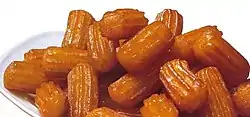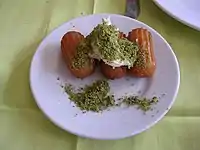Tulumba
Tulumba or Bamiyeh (Persian: بامیه) is a deep-fried dessert found in Iran and the regional cuisines of the former Ottoman Empire. It is a fried batter soaked in syrup, similar to jalebis and churros. It is made from unleavened dough lump (about 3 cm long) given a small ovoid shape with ridges along it using a pastry bag or cookie press with a suitable end piece. It is first deep-fried to golden colour and then sugar-sweet syrup is poured over it when still hot. It is eaten cold, and is traditionally served for Persian New Years known as Nowruz and other special occasions.
 | |
| Alternative names | balah ash-sham (Arabic: بلح الشام) |
|---|---|
| Type | Dessert |
| Place of origin | Persia |
| Region or state | Countries of the former Ottoman Empire, Balkans, Middle East, South Caucasus |
| Main ingredients | Flour, butter, salt, water, syrup |
Name
Tulumba literally means 'pump' in Turkish from Italian: tromba. The dessert is called pomba in Cypriot Greek and bombacık in Cypriot Turkish. In Armenian cuisine it may be called either pomp or tulumba (Armenian: թուլումբա). Tulumba features in Albanian, Serbian, Bosnian, Bulgarian, Macedonian, Greek (Greek: τουλούμπα), Azeri (Azerbaijani: Ballıbadı) and Turkish cuisines. The sweet is also found in Persian cuisine as bamiyeh (Persian: باميه). In Hejazi it is called ṭurumba (Arabic: طُرُمْبَة) directly from Italian: tromba, but in Egyptian and some Arab cuisines it is called balah ash-sham (Arabic: بلح الشام), and in Iraqi cuisine it is known as datli (Arabic: داطلي).
Main ingredients
It is made from a yogurt and starch based dough, which is fried before being dipped in syrup. It is a special sweet often enjoyed at Iftar in Ramadan.[1] It is also commonly served with its counterpart, the jalebi, which is prepared the same way, but the only difference is that it has a web-like arrangement consisting of strips of dough.
Gallery
 Tulumba
Tulumba Tulumba
Tulumba Tulumba with kaymak and pistachio
Tulumba with kaymak and pistachio.JPG.webp) Tulumba cross-section (front)
Tulumba cross-section (front)
See also
References
- "Muslims break fast on first day of Ramadan". USA Today. Associated Press. November 4, 2005. Retrieved August 19, 2010.
